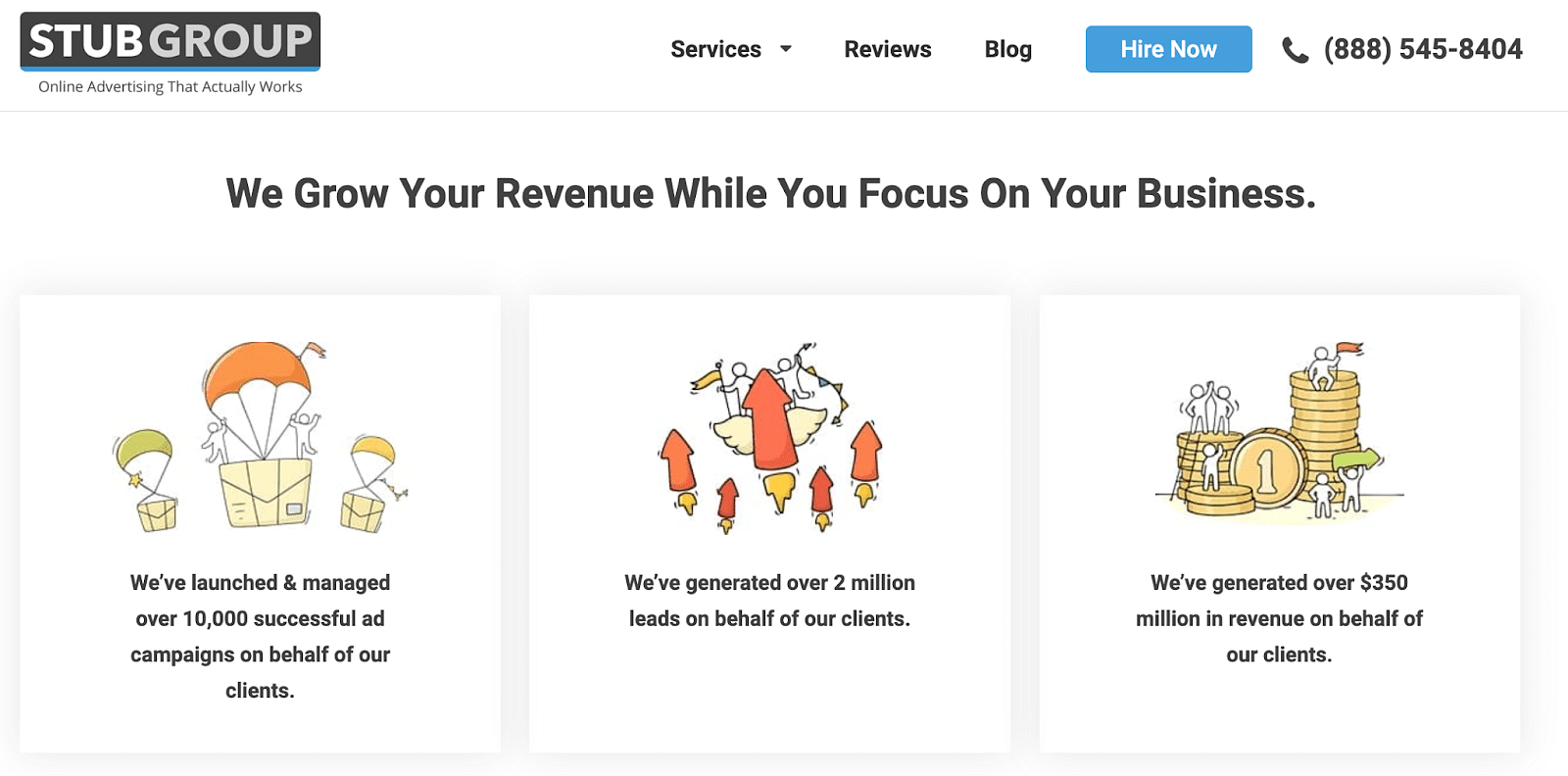
Is ranking number one on Google the best for you? Here’s how you can truly leverage digital advertising to get your business noticed
By Jim James, Founder EASTWEST PR and Host of The UnNoticed Entrepreneur.
Stub Group specialises in Google AdWords, LeadsGO, and other platforms in the digital advertising space. In the new episode of The UnNoticed Entrepreneur, Chief Executive Officer (CEO) John Horn talked about how his company helps entrepreneurs get noticed using Google and Facebook ads.
Image from LinkedIn
Advertising is About Results
Stub Group helps businesses get noticed by connecting them with people who are searching for the products and services that they sell. These include people who don’t even know to search for them yet, but who need to be made aware that those products exist. Whether it’s through Google’s search engine or Facebook feed, they’re helping companies get in front of the right people — at the right time.
For many, Facebook and Google ads seem to be complicated, tech-heavy things. And John often gets asked by businesses if they need to hire a third party to help them with these or if they can work directly with the platforms.
If you’re a business owner, you can do both. However, your concern should be more about: Are you going to get good results? It’s the hairier question because, as mentioned, these are complicated platforms. It’s hard to figure out how to profitably spend money on them.
Agencies like Stub Group eat, sleep, and breathe advertising. They’re there to figure out how to best leverage the algorithms so they can maximise the returns that they’re driving for their clients. They also help save time for their busy clients who are trying to run a business. In reality, entrepreneurs often don’t have the time to see what’s working and not working when it comes to online advertising.
A Numbers Game
At Stub Group, they build every campaign by understanding their clients’ businesses as much as they can.
They look at and understand their numbers. What can they afford to spend to acquire new business based on their margin? If they’re selling products, how much is a new order worth to them? What about the lifetime value of a customer? Are they going to be a one-and-done customer or are they going to be with them for years and make recurring revenue?
Screengrab from Stub Group
Their work is about figuring out these numbers and translating them to the advertising side of things. They will help determine how much can the business afford to acquire a new customer; how much they need to pay to get relevant people to their website. They will also look at the conversion rates. What can they reasonably assume? How many of those people visiting the website will actually take the desired course of action — whether it’s to purchase a product, fill out a form, or call the client?
In essence, they try to work their way backwards. They use their clients’ numbers to see what’s realistic in the advertising space. Then, they advise their client if a certain strategy cannot work — or if there’s an opportunity to go ahead, test things out, start spending money and getting that good traffic, and then optimise and improve over time to hit the client’s goals.
A big part of their work is also about figuring out which platforms should they use for a client. They usually start with the lowest hanging fruit where they can get the biggest bang for their initial buck. Then, they work and scale from there.
If a client is selling something that people are actively looking for, their target customers would typically do a Google search. When someone types in a query, their goal is for their client to be a solution that comes up for that. And the best way to do that is by advertising, testing messaging, and figuring out how to get those people to the client’s website.
Is Occupying the Top Search Rank Important?
When you search for a product or a service, you’ll get multiple results. With such a competition, you might be asking: How important is it for a company to be the top one on that list?
Stub Group tells their clients that it’s actually not the right question to be asking.
Image from Unsplash
Think of Google as an auction. When you run an ad, you’re telling Google the types of keywords or searches that you want your ad to show up for — and the amount you're willing to pay for that traffic. Every single time someone searches those keywords on Google, an incredibly dynamic auction takes place. All the different advertisers who want that type of traffic compete against each other based on the quality of their ads, how likely someone is to click their ads, and how much they're willing to pay a click to have their ads show up.
You may get to a scenario where you’ll be number one. It’s a fantastic thing because a lot of people will be clicking on the first thing that comes up. However, there will also be scenarios wherein it can be too expensive to have that first position, and will be less costly and more suitable for the numbers that you have to be in the second, third, or fourth positions.
At the end of the day, advertising is less about targeting a position. Instead, it’s more about having a good foundational strategy of going after the right people with the right bids and numbers; of having the best ads on your side to hit your profitability goals, whatever they may be.
Where Your Ad Leads Matters, Too
Advertising to people is just the beginning of a journey. Often, the ad that someone sees is the first engagement that your business will be having with them. In other cases, an ad could be a follow-up engagement. Because there are instances when people would see multiple ads first before clicking on the link.
When you advertise, don’t just focus on the first impression that your ad will make. Just as important is where you’ll be sending them after they click on your ad.
If you’re spending lots of money on getting people to your website, then you've got a website that doesn't load quickly — then it will only make people feel annoyed and they will click back even before your content loads. It can also be that your homepage only contains general information whereas your ad is talking about a very specific problem. In this case, people will think that your website isn’t relevant and will just click away.
Either way, you’ll be wasting all kinds of money on your ad spend.
Image from Unsplash
This is where Stub Group comes in. They will help you determine who are you targeting and where are they in the conversion funnel based on what they're typing in. Are you going after people who have to be educated first about why they need your product? Or are you targeting those who've been through that and they're about ready to make a decision and are simply looking for the right place to go to?
They will help you think through these realities and craft the landing pages that will best match the pain points that the people clicking on your ads are experiencing — and will be best suited to funnel them to do whatever action that you want them to take.
The Challenges of Tracking the Customer Journey Today
Transitioning from a desktop to a mobile search (and vice versa) and location-based advertising have made it more difficult for businesses to track the journey that people are taking.
For instance, someone may start their research on their phone when they’re riding the bus. When they get home, they’d go to their computer and go back to the website. They may also see a Facebook ad about what they’re searching for and click on that. In this type of journey, there’s a lot of segmentation and data points.
What Stub Group does is make those a unified journey based on what they can see on the tracking side. Some of that comes down to tracking and identifying people across devices or platforms. Some entail testing and modelling things out based on their client’s ad spend and what happened in terms of sales or website traffic. But all of these boil down to doing ongoing optimisation and measuring as much traffic data as possible.
The ability of customers to block cookies has also definitely made it more challenging to track traffic. Last year, when Apple rolled out their iOS 14 update, it made it easier for iPhone users to opt-out of being tracked across apps and mobile websites. This didn’t only make it more difficult to follow the customer journey but also to do the types of targeted advertising that businesses used to be able to do.
This means that you just need to take different strategies. Because at the end of the day, people are still the same: They're still using the devices and they're still looking for products and services. It’s a matter of getting more creative.
Image from Unsplash
For instance, when running Facebook ads, you can send all the traffic to landing pages specially built for Facebook. That way, you’ll know that the people who have filled out the forms on those pages are from Facebook even if Facebook Pixel (its tracking platform) itself isn’t able to track every single one of those form submissions.
Again, this is all about going back to the basics of running good campaigns with good messaging, sending people to well-crafted landing pages, and trying to fill gaps in the back end as much as possible.
How Do You Make A Good Ad Campaign?
When people talk about good campaigns, they tend to focus on vanity metrics, such as ad impressions and click-through rates. However, none of these really matters if they’re not increasing your bottom line as a business.
For John, a good campaign is about helping you make more profit, hit your key performance indicators (KPIs), and scale your campaign so you can continue doing that better over time. And these can be attained through messaging, targeting, and back-end tracking.
B2B vs B2C Advertising
Stub Group does a lot of work in both Business-to-Business (B2B) and Business-to-Consumer (B2C) advertising spaces.
One difference that often comes into play is the lag between the time someone clicks on an ad and the time they actually take an action on a client’s website. In the B2B space, there’s a longer time lag because a business researches multiple options and puts out more requests and quotes from different vendors.
This is why when you’re running ad campaigns, you need to factor in that timeframe. If it takes a month for someone to make a decision, take action, and move forward with you, it will affect how you’ll be able to look at your data to analyse how much money you’re making from your campaigns.
In the B2C space, consumers move more quickly. However, there are cases when there could be a longer lag as well (e.g. a certain product or service has a higher price point and it prompts the consumer to decide longer if they’ll avail of it or not).
Image from Unsplash
In B2B, it can also be that the person who initially saw your ad is not the decision-maker and they first need at least one stakeholder to sign off before proceeding. In these instances, you have to make it easy for those people to share your information with their company’s decision-makers and eventually get that buy-in from stakeholders.
On the consumer side, the process looks different because the consumer is the sole or co-decision-maker themselves (as in the case of couples).
On Ad Formats
The placement and platform are going to dictate which type of ad you're running. For example, if you’re on Google search, you’re going to have text ads. If you’re on Facebook, you could do a bunch of different things.
Generally, the more engaging and visually stimulating your ads are, the better they will be. If you can, you should also create video ads. Because, typically, video performs better than image, and image performs better than text.
The same applies to your website and landing pages. If you can offer your visitors a video explaining your product or a video featuring a customer’s testimonial, you’re going to have a greater emotional impact than just plain imagery.
Same thing with imagery versus text. If you simply have a page with a white background and black text, it will look outdated compared to your competitors and it will make it harder for you to emotionally connect with your consumers.
How Much Do You Need to Spend?
The minimum viable budget for ad campaigns depends on each client. However, there are some patterns that can be drawn based on existing website traffic data. For instance, traffic going to a website that offers plumbing service is going to have a very different cost than the traffic for a lawyer’s page or an eCommerce website.
Stub Group can look at those, do projections, and approximate what traffic is going to cost. So if a client wants a minimum of 100 clicks a week, then they can estimate what it’s roughly going to cost and what their monthly budget would look like. Once they get those 100 clicks per week, they can start to look at enough data and see what’s working and what’s not. Based on these, they can make improvements over time.
The minimum number of clicks is dependent on the type of business that they’re working with. The timeframe to do these is also based on the type of product or service of the client. If it’s something that people can impulsively buy, it will take a shorter time to collect data and see a pattern or trend compared to an offering that prompts people to do more research.
Image from Unsplash
Saving time and money is a big benefit that comes with working with an ad agency like Stub Group. And there are plenty of options available out there in terms of how much it’s going to cost to avail of these agencies’ services.
At the bare minimum, if you’re working with a good agency, you’re most likely to spend at least $1,000 a month. This comes on top of the percentage of ad spend that you also need to pay. Typically, an agency takes between 10 to 20% of your ad spending on Google or Facebook and counts that as their fee as well. The idea behind is that the more you're spending, the more work they need to do to manage that spending.
The final cost really depends on the business. Sometimes, it can be too high that it just doesn’t make sense to work with a third party. But if you look at it like how you need to hire a plumber for your home, one wrong do-it-yourself move and things can worsen. The water may start spilling into your living room. And to fix that, you need to hire restoration teams, carpenters, and mould cleaning companies. It becomes too complex that you wish you could have just paid that money to get an expert plumber from the beginning.
Getting Stub Group Noticed
To get Stub Group noticed, they do exactly what they offer. They run a lot of digital advertising campaigns themselves, targeting people who are searching online for an agency or a partner to help them with their advertising needs.
They also do other types of outreach as well, including public relations (PR), email and other forms of outbound marketing, and podcast interviews. They are also finding agencies that do search engine optimisation (SEO), PR, and podcasts — team up with them and make a win-win situation for both their clients.
To learn more about Stub Group, visit https://stubgroup.com.
This article is based on a transcript from my podcast The UnNoticed Entrepreneur, you can listen here.
Cover image by Mitchell Luo on Unsplash








